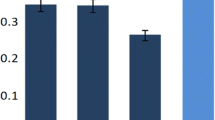Abstract
Vibrio parahaemolyticus is a moderately halophilic, salt-requiring organism that exhibits optimal growth at approximately 3% salt. Thus, salinity stress is one of the most important stimuli during its lifecycle. The bacterium possesses a strong ability to form biofilms on surfaces, which are thought to be involved in protecting it from adverse environmental conditions. In the present study, salinity-dependent biofilm formation by V. parahaemolyticus was investigated by combining crystal violet staining, colony morphology, intracellular c-di-GMP quantification and quantitative PCR. The results showed that biofilm formation by V. parahaemolyticus was significantly enhanced in low salinity growth conditions and was affected by incubation time. In addition, low salinity reduced intracellular c-di-GMP degradation in V. parahaemolyticus. Transcription of genes encoding ScrABC and ScrG proteins, which are involved in intracellular c-di-GMP metabolism, was inhibited by low salinity growth conditions. Thus, reduced intracellular c-di-GMP degradation in V. parahaemolyticus in low salinity growth conditions may be mediated by repression of scrG and scrABC transcription. Taken together, these results demonstrated for the first time that salinity regulates biofilm formation and c-di-GMP production in V. parahaemolyticus.




Similar content being viewed by others
Data Availability
All data generated or analyzed during this study are included in the manuscript. Further inquiries may be directed to the corresponding authors.
References
Raszl SM, Froelich BA, Vieira CR, Blackwood AD, Noble RT (2016) Vibrio parahaemolyticus and Vibrio vulnificus in South America: water, seafood and human infections. J Appl Microbiol 121(5):1201–1222
Osei-Adjei G, Huang X, Zhang Y (2018) The extracellular proteases produced by Vibrio parahaemolyticus. World J Microbiol Biotechnol 34(5):68
Whitaker WB, Parent MA, Naughton LM, Richards GP, Blumerman SL, Boyd EF (2010) Modulation of responses of Vibrio parahaemolyticus O3:K6 to pH and temperature stresses by growth at different salt concentrations. Appl Environ Microbiol 76(14):4720–4729
Yildiz FH, Visick KL (2009) Vibrio biofilms: so much the same yet so different. Trends Microbiol 17(3):109–118
Ashrafudoulla M, Mizan MFR, Park SH, Ha SD (2021) Current and future perspectives for controlling Vibrio biofilms in the seafood industry: a comprehensive review. Crit Rev Food Sci Nutr 61(11):1827–1851
Dong X, Zhang Y, Yang R, Xie C, Zhou D (2014) Effect of salinity and temperature on motility of Vibrio parahaemolyticus [in Chinese]. Military Medical Sciences 12:962–964
Enos-Berlage JL, Guvener ZT, Keenan CE, McCarter LL (2005) Genetic determinants of biofilm development of opaque and translucent Vibrio parahaemolyticus. Mol Microbiol 55(4):1160–1182
Kim YK, McCarter LL (2007) ScrG, a GGDEF-EAL protein, participates in regulating swarming and sticking in Vibrio parahaemolyticus. J Bacteriol 189(11):4094–4107
Ferreira RB, Antunes LC, Greenberg EP, McCarter LL (2008) Vibrio parahaemolyticus ScrC modulates cyclic dimeric GMP regulation of gene expression relevant to growth on surfaces. J Bacteriol 190(3):851–860
Zhang Y, Qiu Y, Gao H, Sun J, Li X, Zhang M, Xue X, Yang W, Ni B, Hu L et al (2021) OpaR controls the metabolism of c-di-GMP in Vibrio parahaemolyticus. 12(1319)
Makino K, Oshima K, Kurokawa K, Yokoyama K, Uda T, Tagomori K, Iijima Y, Najima M, Nakano M, Yamashita A et al (2003) Genome sequence of Vibrio parahaemolyticus: a pathogenic mechanism distinct from that of V cholerae. Lancet 361(9359):743–749
Fang N, Gao H, Wang L, Qu S, Zhang YQ, Yang RF, Zhou DS (2013) Optimized methods for biofilm analysis in Yersinia pestis. Biomed Environ Sci 26(5):408–411
Gao H, Ma L, Qin Q, Qiu Y, Zhang J, Li J, Lou J, Diao B, Zhao H, Shi Q et al (2020) Fur represses Vibrio cholerae biofilm formation via direct regulation of vieSAB, cdgD, vpsU, and vpsA-K transcription. Front Microbiol 11:587159
Gao H, Zhang Y, Yang L, Liu X, Guo Z, Tan Y, Han Y, Huang X, Zhou D, Yang R (2011) Regulatory effects of cAMP receptor protein (CRP) on porin genes and its own gene in Yersinia pestis. BMC Microbiol 11:40
Jenal U, Reinders A, Lori C (2017) Cyclic di-GMP: second messenger extraordinaire. Nat Rev Microbiol 15(5):271–284
Yang L, Zhan L, Han H, Gao H, Guo Z, Qin C, Yang R, Liu X, Zhou D (2010) The low-salt stimulon in Vibrio parahaemolyticus. Int J Food Microbiol 137(1):49–54
Kalburge SS, Whitaker WB, Boyd EF (2014) High-salt preadaptation of Vibrio parahaemolyticus enhances survival in response to lethal environmental stresses. J Food Prot 77(2):246–253
Wong HC, Peng PY, Han JM, Chang CY, Lan SL (1998) Effect of mild acid treatment on the survival, enteropathogenicity, and protein production in Vibrio parahaemolyticus. Infect Immun 66(7):3066–3071
Karlsen C, Paulsen SM, Tunsjo HS, Krinner S, Sorum H, Haugen P, Willassen NP (2008) Motility and flagellin gene expression in the fish pathogen Vibrio salmonicida: effects of salinity and temperature. Microb Pathog 45(4):258–264
Larsen MH, Blackburn N, Larsen JL, Olsen JE (2004) Influences of temperature, salinity and starvation on the motility and chemotactic response of Vibrio anguillarum. Microbiology 150(Pt 5):1283–1290
Acknowledgements
We thank International Science Editing (http://www.internationalscienceediting.com) for editing this manuscript
Funding
This study was supported by grants from the National Natural Science Foundation of China (Grant No. 82072239) and the Fundamental Research Funds for the Central Universities (JUSRP121061).
Author information
Authors and Affiliations
Contributions
YZ, DZ and RL designed, organized and supervised the experiments, interpreted the results and edited the manuscript. XL, JF, MZ, XX and QW performed the laboratory experiments. XL drafted the manuscript.
Corresponding authors
Ethics declarations
Conflict of interest
The authors declare that there are no conflict of interest regarding the publication of this article.
Ethical Approval
Not applicable.
Code Availability (Software Application or Custom Code)
Not applicable.
Additional information
Publisher's Note
Springer Nature remains neutral with regard to jurisdictional claims in published maps and institutional affiliations.
Rights and permissions
About this article
Cite this article
Li, X., Sun, J., Zhang, M. et al. The Effect of Salinity on Biofilm Formation and c-di-GMP Production in Vibrio parahaemolyticus. Curr Microbiol 79, 25 (2022). https://doi.org/10.1007/s00284-021-02723-2
Received:
Accepted:
Published:
DOI: https://doi.org/10.1007/s00284-021-02723-2




